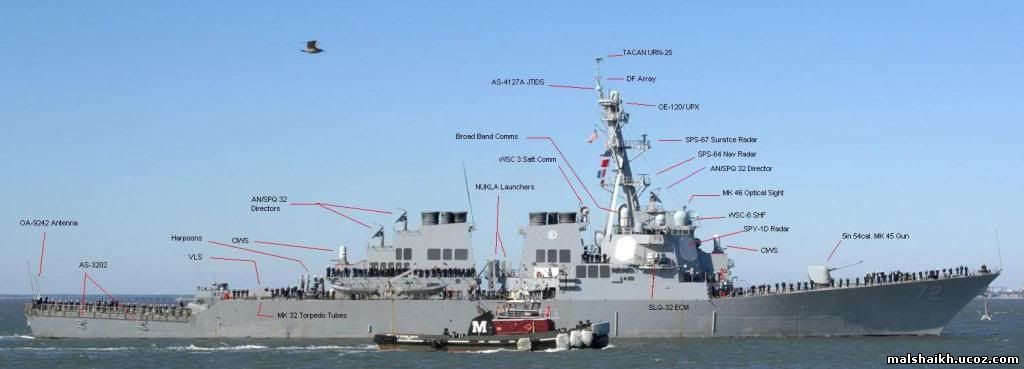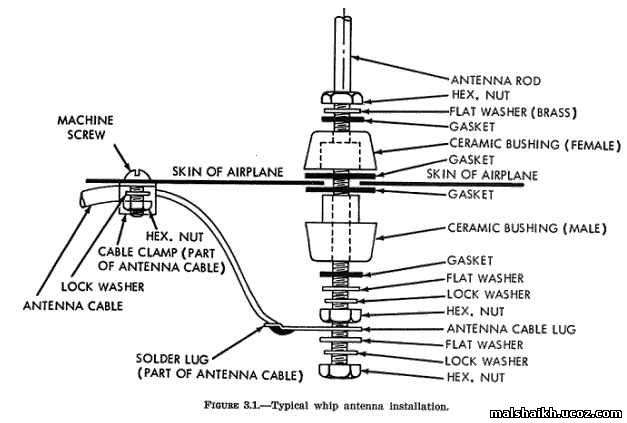الهوائيات (Antennas)
تعدّ الهوائيات من أهم مكونات أنظمة الاتصال اللاسلكي، وهي عبارة عن أداة تحول إشارة المعلومات إلى موجات كهرومغناطيسية،

حيث يمكن وصلها بأي جهاز إرسال مضبوط على نفس التردد. تتميز الهوائيات بخصائصها التبادلية الفريدة مما يسمح لها بالحفاظ على ثبات عملها أثناء عمليتي الإرسال والاستقبال.
ولأنها رنانة (Resonant)، فيمكنها أن تعمل على نحو فعال حتى في نطاقات التردد الضيقة.
نمط الإشعاع (Radiation Pattern)
هناك طريقة معينة في الهوائيات تبعث بها الإشارة التي قد غذيت بها كإشعاعات إلى الفضاء المحيط، وهو ما يعرف بنمط الإشعاع، ولكل نوع من الإشعاعات هدف خاص، حيث تقوم هذه الأنماط بوصف أساس لشدة المجال الإشعاعي في كل الاتجاهات حول الهوائي. ويتم قياسها باستخدام مخطط ثنائي الأبعاد، لكنها في الواقع ثلاثية الأبعاد في الطبيعة، ويمكن تمثيلها باستخدام الإحداثيات العادية (CoordinatesRectangular) أو القطبية (Polar Coordinates).
عوامل بناء الهوائي
من أجل مواكبة الطول الموجي المناسب والذي تشع به الإشارات، لا بد من تحديد طول الهوائي على أساس الترددات الراديوية. كلما زاد تردد الأمواج الراديوية، قل طول الهوائي .
ويمكن تصنيف الهوائيات حسب مسارها إلى هوائيات موجهة (Directive) و قطاعية (Sectorial) والهوائيات ذات الاتجاهات المتعددة (Omnidirectional). الهوائيات الموجهة لديها عرض إشعاع (Beamwidth) ضيق وكسب (Gain) عالي فهي مناسبة للربط عبر مسافات طويلة، أما الهوائيات القطاعية فلديها مسار واحد محدد وعرض الإشعاع فيها أوسع من تلك في الموجهة، غير أن الهوائيات ذات الاتجاهات المتعددة تشع في كل الاتجاهات على نفس النمط.
يمكن أن يختلف البناء العملي للهوائيات حسب تطبيق استخدامها، حيث يمكن أن تكون على شكل قطع مكافئ (Parabolic Dishes) أو مثل فنجان الشاي، يمكن أن تأخذ أي شكل أثناء عملية البناء
أنواع الهوائيات
- ربع طول موجي أفقي: إنه شكل بسيط للهوائي ويستعمل بشكل واسع لقلة التكلفة والتركيب السهل للهوائي . ويقوم بإرسال إشارة الاستقطاب رأسياً باستخدام الأسلوب الأفقي التي تتكون من مجموعة من العناصر المعروفة باسم المجسمات (Radials)، عناصرها هي ثنائي القطب من ¼ عنصر الموجة واثنين من عناصر ¼ أساس الموجة بميل 45 درجة .
- هوائي ياغي (Yagi Antenna): نصف موجة، مركز تغذية يعادل هوائي ثنائي القطب بمثابة عنصر نشط من هوائي ياغي. وهو يتألف من مجموعة من قضبان خطية تسمى “عاكسات” تُرتَّب موازية لبعضها البعض. يتم نشر الموجات الكهرومغناطيسية من خلال الموجِّهات. مع عرض إشعاع أفقي من حوالي 20 درجة، وكسب 20dBi، وهي تستخدم أساسا لربط نقطة بنقطة .
- طبق مكافئ (Parabolic Dish): عندما يكون هناك حاجة لهوائيات قادرة على تحقيق كسب (Gain) أعلى، تستخدم عاكسات القطع المكافئ. إنها هوائيات توجيهية حيث تكون الاتجاهية (Directive) والكسب (Gain) أعلى ما يمكن، لكنها صعبة التركيب والصيانة نظراً لحجمها الكبير كما أن انحرافها بفعل الرياح هو أمر محتمل جداً.
وبصرف النظر عن هذه الأنواع الشائعة، فهناك العديد من الهوائيات مثل هوائيات القطاعية (Sectorial) المستخدمة في لوحات الهاتف ولوحات التصحيح (Patch Panels) وتستخدم خصيصاً للتغطية الداخلية.
English version
The antennas of the most important components of wireless communication systems, a transformation tool signal information to the electromagnetic waves, which can be connected to any device is set to send the same frequency. Featuring the unique characteristics of antennas reciprocity, allowing it to maintain the stability of its work during the processes of transmission and reception. Because she resonant (Resonant), it can operate effectively even in narrow frequency bands.
Radiation pattern (Radiation Pattern)
There is a certain way of antennas send out the signal that has been fed by Kahaaat to the ocean space, which is known as the radiation pattern, and each type of radiation a particular target, where are these patterns as the basis of the intensity of the radiation field in all directions around the antenna. And it is measured using a two-dimensional diagram, but they are actually a three-dimensional in nature, and can be represented using (Coordinates Rectangular) or regular polar coordinates (Polar Coordinates).
Antenna construction factors
In order to keep up with the appropriate wavelength, which radiates its signals, it is necessary to determine the length of the antenna to the radio-frequency basis. Greater frequency radio waves, the smaller the length of the antenna.
The antennas can be classified according to the track directed antennas (Directive) and sectoral (Sectorial) and antennas with multiple trends (Omnidirectional). Antennas destined to have a beamwidth (Beamwidth) tight and gain (Gain) high, it is suitable to connect over long distances, and the antennas sectoral It has one path specified and display radiation where wider than those in the targeted, but the antennas with multiple trends radiate in all directions on the same pattern .
Can the practical construction of the different antennas used by the application, which can be in the form of a parabola (Parabolic Dishes) or like a cup of tea, you could take any form during construction
Types of antennas
1A quarter wavelength Horizontal: It is a simple form of the antenna and is widely used for low cost and easy installation of the antenna. It sends a signal polarized vertically using the horizontal method, which consists of a group of elements known as maquettes (Radials), its elements are dipole of ¼ wave component and two component basis ¼ wave inclination of 45 degrees.
2Yagi antenna (Yagi Antenna): half-wave, a feeding center equivalent dipole antenna serves as an active element of the Yagi antenna. It consists of a set of linear bars called "reflectors" arranged parallel to each other. Electromagnetic waves are propagated through routers. Show with a horizontal radiation of about 20 degrees, gain 20dBi, it is mainly used for connecting point by point.
3Parabolic dish (Parabolic Dish): when there is a need for antennas able to gain (Gain) higher, use reflectors parabola. It antennas guidelines where the directivity (Directive) and gain (Gain) as high as possible, but difficult to install and maintain because of its large size and the deviation caused by wind is very unlikely.
Apart from these common species, there are many antennas such as sectoral antennas (Sectorial) used in the paintings phone patch panels (Patch Panels) specially used for internal coverage.

|